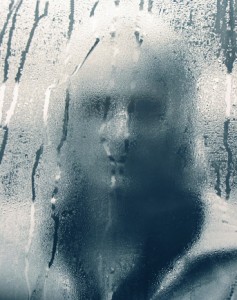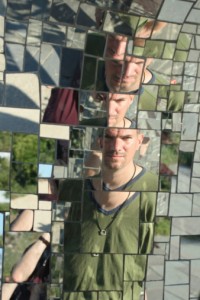The Whole-Half Self (Part 4)
By Asher Crispe: February 11, 2013: Category Inspirations, Thought Figures
Readings of R.D. Laing’s Existential Psychology
 The ‘coinage’ of self that avoids the pitfalls of self-idolization issues from fire and remains fire. In the words of the Talmud Yerushalmi Shekalim (1:4) “Rabbi Meir said [that the half shekel is] like a type of fire coin that God brought out from under the throne of Glory….” While the specific words matbaiya shel aish can be read as a ‘coin of (from) the fire’ (where the coin was forged from molten metal), they could also be rendered as a ‘fire coin,’ meaning, that the coin itself was ‘fire.’ Normally we do not think of the substance of this coin in terms of ignition–rather we get commentary references to silver. However, in Hebrew, silver is kesef (it also denotes money in general) which shares a root with the word kasaf “longing” or “desire.” The halfness or sense of incompleteness of self weighs in as the figurative fire of desire that both constitutes the currency-value of that longing and deconstructs itself at the same time. The fire coin makes itself by continuously unmaking itself; its materiality is that which dematerializes– that works through the material to the spiritual. Just as physical objects of desire are seen as replacements or markers for spiritual absences, the fire coin signifies a self-consuming nature (matbaiya [coin] comes from the root teva [nature]).
The ‘coinage’ of self that avoids the pitfalls of self-idolization issues from fire and remains fire. In the words of the Talmud Yerushalmi Shekalim (1:4) “Rabbi Meir said [that the half shekel is] like a type of fire coin that God brought out from under the throne of Glory….” While the specific words matbaiya shel aish can be read as a ‘coin of (from) the fire’ (where the coin was forged from molten metal), they could also be rendered as a ‘fire coin,’ meaning, that the coin itself was ‘fire.’ Normally we do not think of the substance of this coin in terms of ignition–rather we get commentary references to silver. However, in Hebrew, silver is kesef (it also denotes money in general) which shares a root with the word kasaf “longing” or “desire.” The halfness or sense of incompleteness of self weighs in as the figurative fire of desire that both constitutes the currency-value of that longing and deconstructs itself at the same time. The fire coin makes itself by continuously unmaking itself; its materiality is that which dematerializes– that works through the material to the spiritual. Just as physical objects of desire are seen as replacements or markers for spiritual absences, the fire coin signifies a self-consuming nature (matbaiya [coin] comes from the root teva [nature]).
The nature of nature as a coin would appear to fix nature just as the coin assumes a definite form. The patterns of nature, when regarded as immutable, have been minted and placed into circulation. We buy and sell with them all manners of experience within the world. If we consider nature as human nature, then the static status of the self (shekel = nefesh [soul]) will shackle us within an inflexible manner of being. Once cooled, the liquid metal of the self would become fated to carry on by its inertia, the inner conformity of the idol-self. In addressing this, the Talmud presents us with a sense of self that desires to be more than it is. What am I? A flame? A human torch? Our painting of this fire coin redefines spontaneous self-combustion. My partiality of self is defined by its lack of definition, resolved by dissolving, appearing by disappearing.
From here we want to go into the back story and add a new layer of explanation for the raison d’être of our half shekel coin and its potential to counteract the sin of the Golden Calf (Shemot/Exodus 32:1-35) but first we have to look into its root in an earlier narrative in the Torah. According to Kabbalah, there is a prequel to this infamous episode of idol worship in the calamity of eating from the Tree of Knowledge in the Garden of Eden. [Later on we will see how the same cast of characters reprise their roles in new performances with slight variations.] According to the Sages, the snake’s poison was transfused into the human condition causing a kind of spiritual impurity (zuhama) which we might liken to depression or desensitization. When the Torah was given on Mount Sinai, the tradition relates that the souls of the people were cleansed of this negative psychic residue. Only once the people fashioned the golden calf did it return (although not to the same degree as before according to the Chida in his Nitzutei Orot commentary on the Zohar III 14b). What was the source of this impurity and how was it echoed with the golden calf?
In the original story, the first marriage pair of Adam and Chava/Eve exemplified ‘naked’ human relations. By nakedness, the stress is on the psychological nudity and transparency in the sense of appearing as one actually is. If I can just be myself without resorting to the use of camouflage trying to conceal the real me with some false projection of self, then I can hope to avoid duplicity in my relating to the other. Once I become ‘self-conscious’ in front of the other (this is the significance of the internalizing [eating] from the Tree of Knowledge), then I feel compelled to dress myself in a more palatable self-image behind which I can hide. The injection of the poison of the snake entices me into a state of ‘self-consciousness.’ I am filled (my sense of self) with a paralytic. I become uncomfortable in my own skin. Hence I fabricate a second skin in the form of clothing to mediate my embarrassment before the other.
Now, let’s replay this breakup of the simple wholeness of self into a complex or multiplex one in terms of Laing’s descriptions:
“No one feels more ‘vulnerable’, more liable to be exposed by the look of another person than the schizoid individual. If he is not acutely aware of being seen by others (‘self-conscious’), he has temporarily avoided his anxiety becoming manifest by one or other of two methods. Either he turns the other person into a thing, and depersonalizes or objectifies his own feelings towards this thing, or he affects indifference. The depersonalization of the person and/or the attitude of indifference are closely related but not quite identical. The depersonalized person can be used, manipulated.” (p.76)
What better way to hide from the gaze of the other in attempting to ameliorate the pinch of ‘self-consciousness’ than to wrap oneself in a disguise? (Parenthetically, the day in the Jewish calendar which is devoted to the treatment of schizophrenia is Purim. On Purim, the custom is to put on masks and costumes, to be someone that you’re not. This practice reinforces the idea that we are all onions with layer upon layer to be peeled back as we probe from the outside in. Nonetheless, all of the layers have some underlying unity in that the ‘skins’ were outgrowths of the core person.) Turning the other (and the self to some degree) into a ‘thing’ in Laing’s locution, would be comparable to the midrashic emphasis on the shift in the corporeality of Adam and Chava/Eve from a transparent skin of ‘light’ to an opaque fleshy skin that resulted from the eating from the Tree of Knowledge.
Here we have two types of embodied self. The transparent self has nowhere to hide nor does it acknowledge the truth of an absolute inside/outside distinction. By contrast, the opaque self is depersonalized. To see only skin deep is to objectify the self (and the other). When I take hold of a person I am grasping at their skin; it submits to my manipulations. The it-ness of skin, when it is drained of subjectivity, desensitizes us to the inner relation of I-Thou. We become indifferent to it.
 All the skin that we see is dead skin (the snake is especially well-known for its shedding of dead skins). The false-self too has a generally deadening effect. Such a perception of the self is even disconnected from one’s own body. For Laing, the ‘body’ becomes grouped with the ‘other’ as something foreign to me. Thus, under such circumstances I can pretend that anything I do–no matter how I come across–is not really me. As Laing expresses it: “The individual’s self-relationship becomes a pseudo-interpersonal one, and the self treats the false selves as though they were other people whom it depersonalizes.” (p.74). Consequently we can get away with saying things like ‘I am not myself’ and somehow everyone understands to some degree what we mean on account of their having had a similar experience.
All the skin that we see is dead skin (the snake is especially well-known for its shedding of dead skins). The false-self too has a generally deadening effect. Such a perception of the self is even disconnected from one’s own body. For Laing, the ‘body’ becomes grouped with the ‘other’ as something foreign to me. Thus, under such circumstances I can pretend that anything I do–no matter how I come across–is not really me. As Laing expresses it: “The individual’s self-relationship becomes a pseudo-interpersonal one, and the self treats the false selves as though they were other people whom it depersonalizes.” (p.74). Consequently we can get away with saying things like ‘I am not myself’ and somehow everyone understands to some degree what we mean on account of their having had a similar experience.
In Part Five we will continue to hammer out the connection of a depersonalized false-self with the Golden Calf as the idol image.
http://www.interinclusion.org/inspirations/the-whole-half-self-part-5/
http://www.interinclusion.org/inspirations/the-whole-half-self-part-3/























;)
;)
;)
;)
;)
;)
;)
;)
;)
;)
